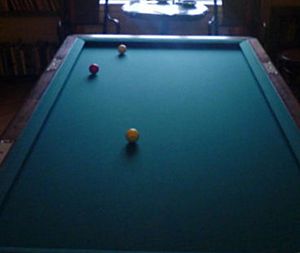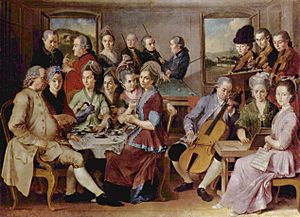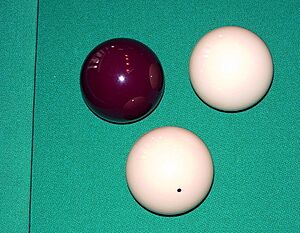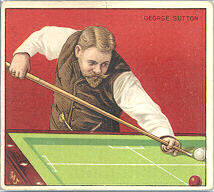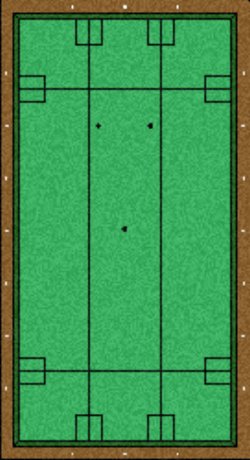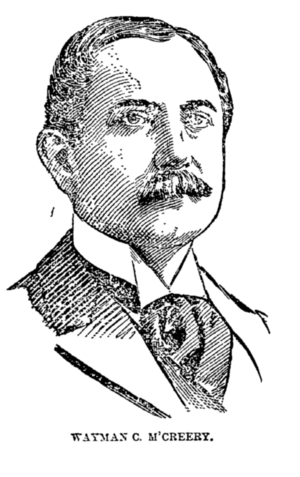Carom billiards facts for kids
Carom billiards, also called carambole billiards, is a group of billiards games. These games are played on tables covered with a special cloth. Players use long sticks called cues to hit heavy balls. Unlike snooker or pool tables, carom billiards tables do not have pockets.
In these games, the main goal is to score points. You score a point by hitting your own ball (called a cue ball) so it touches the other two balls on the table. No one knows exactly when the first carom game was invented. However, it is believed that carom billiards games started in the 1700s in France, Europe.
There are many different carom billiards games, each with its own rules. Some popular ones include straight rail, cushion caroms, balkline, three-cushion billiards, and artistic billiards. Some games even mix rules from carom billiards and games played on tables with pockets, like English billiards or American four-ball billiards.
Contents
How the name came about
The word "carom" means to strike and bounce off something. It started being used for pocketless billiards games around the 1860s. It comes from the word carambola, which is used in Spanish and Portuguese. In French, it's spelled carambole.
At first, "carambola" was just the name for the red ball used in billiards. Later, it became the name for the game itself. Some people who study word origins think carambola might have originally been the name of a yellow-orange tropical fruit called a carambola or starfruit. This word came from karambal in the Marathi language of India. However, this idea is often questioned because the fruit doesn't look much like the big red ball, and there's no clear proof.
Equipment
Cloth
Billiards tables have been covered with cloth since the 1400s. A very famous company that makes billiard cloth, Iwan Simonis, started in 1453. Most cloth for carom billiards tables is a type called "baize." It's usually dyed green and made from 100% wool. This cloth is very smooth and fast, letting the balls roll easily across the table.
Green became the common cloth color in the 1500s because it looked like grass. But it also helps players! Our eyes see green more easily than other colors. This means players can play for longer without their eyes getting tired.
Balls
Today's billiard balls are made from "phenolic resin", a very strong type of plastic. Carom billiards balls are usually 61.5 mm (about 2.4 inches) wide. They weigh between 205 and 220 grams (about 7.2 to 7.7 ounces). These balls are quite a bit larger and heavier than the balls used for pool games.
Most carom billiards games use three standard balls:
- One completely white cue ball.
- A second cue ball, sometimes with a red or black dot (to tell it apart from the first cue ball).
- A third, red ball.
Sometimes, the second cue ball is solid yellow. Both types of ball sets are allowed in tournament play.
Billiard balls have been made from many different materials over time. They've been made from clay, wood, ivory, and various plastics. From the 1600s until the mid-1900s, ivory was the most common material. People looked for other materials not just for environmental reasons, but because ivory was very expensive and getting it was dangerous for elephant hunters. A New York billiard table maker even offered a $10,000 prize for a good substitute!
The first useful substitute was "celluloid," an early plastic invented in 1868 by John Wesley Hyatt. However, celluloid had a problem: it was unstable and could sometimes explode when being made.
Billiard cues
The stick used to hit billiard balls, called a billiards cue, is a bit different from a typical pool cue. Billiard cues are often shorter. They have a shorter end cap (called a ferrule) and a fatter bottom part where you grip the stick (called a butt). They also have a wooden screw in the middle instead of metal or plastic. These features make the billiard cue stiffer.
This stiffness helps players hit the larger and heavier billiard balls. It also helps reduce something called "deflection" or "squirt." Deflection happens when you put "sidespin" on a ball by hitting it off-center. This makes the ball spin as it travels, and deflection causes it to go slightly off the straight path you aimed for. A stiffer cue helps keep the ball going where you want it.
Heated slate
Underneath the cloth of billiard tables is a very hard rock called slate. This slate bed is often heated to about 5 °C (9 °F) above room temperature. This heating helps keep moisture out of the cloth, which makes the balls roll and bounce more consistently. It also makes the table play faster.
Heated tables are required for international carom rules, especially for games like three-cushion billiards and artistic billiards. Heating billiard tables is an old practice. Queen Victoria of England (1819–1901) had a heated billiard table that used zinc tubes. Back then, the heat was used to keep ivory balls from changing shape. The first time electric heating was used was for a tournament in December 1927.
History of games

Straight rail
Straight rail, sometimes called French caroms, is believed to have started in the 1700s. The French people made this game popular. The goal of straight rail is simple: you score one point each time your cue ball touches both other balls on the table in a single shot. You win by reaching a certain number of points.
When straight rail was first invented, there were no limits on how points were scored. But players found a trick called crotching. This meant getting two balls very close together in a corner of the table. It made scoring very easy. So, in 1862, a rule was added: you could only score three points when balls were in the corner before at least one ball had to be moved out of the corner.
Even with this rule, players found new ways to score many points. One technique is called "nursing." A "nurse" is when you keep the balls very close together and hit them softly. This lets you score many points without moving the balls much. The most important nursing technique is the rail nurse, where you gently push the balls down a rail, moving them just a little bit with each score.
Professional straight rail was only popular in the United States for a short time, from 1873 to 1879. It was replaced by games designed to stop nursing, which could make the game boring to watch. Today, straight rail isn't very common in the U.S., but it's still popular in Europe. It's considered a good practice game for other carom games. Europe even hosts competitions called pentathlons where straight rail is one of five billiards games played.
Balkline
Balkline games came after straight rail and added more rules to stop nursing. In balkline, the table is divided into marked areas called balk spaces. These spaces limit how many points a player can score when the balls are inside that area.
Instead of just drawing lines in the corners, balkline games divide the whole table into rectangular spaces. Lines are drawn a certain distance from each rail, creating eight "balk spaces." Small rectangles called anchor spaces are also drawn where the lines meet the rails. These were added to stop new nursing tricks that players developed.
Balkline games are named with two numbers. The first number tells you how many inches from the rail the lines are drawn. The second number, after a "dot," tells you how many points you can score in a balk space before a ball must leave it (this number is always one or two). For example, 18.2 balkline means the lines are 18 inches from the rails, and you can only score two points in a balk space before a ball must move out.
Balkline was the main carom game from 1883 to the 1930s. After that, other games like three-cushion billiards became more popular. Balkline is not very common in the U.S. today, but it's still popular in Europe and the Far East.
Cushion caroms
Cushion caroms, also known as the indirect game, likely started in the 1820s in Britain. It came from an older game called the doublet game. Sometimes, people incorrectly call it one-cushion or one-cushion billiards.
In cushion caroms, you score a point by hitting your cue ball so it touches both other balls. But there's a special rule: your cue ball must hit at least one rail of the table before it touches the second ball.
Cushion caroms wasn't played for many years, but it became popular again in the late 1860s. This happened for similar reasons that balkline developed: people were frustrated with straight rail. The nursing techniques made scoring too easy and the game boring to watch. So, as straight rail lost popularity, cushion caroms had a comeback for a while. Today, cushion caroms is rarely played in the U.S., but it still has some popularity in Europe.
Three-cushion billiards
In three-cushion billiards, the goal is to hit your cue ball so it touches both other balls, but your cue ball must hit at least three rails before it touches the second ball. This game likely started in the 1870s. Many believe that Wayman C. McCreery, from St. Louis, helped make the game popular, and some even say he invented it.
The first three-cushion billiards tournament happened in St. Louis in 1878. Leon Magnus from New York City won it. The highest score in one turn was only 6 points. The game wasn't played much before 1907. Many top players didn't enjoy it. But in 1907, after a trophy called the Lambert Trophy was introduced, the game became more popular in the U.S. and around the world.
By 1924, three-cushion was so popular that two famous players from other billiards games agreed to play each other. Willie Hoppe, the world balkline champion, and Ralph Greenleaf, the world pool champion, played a big match. Hoppe won. The game's popularity in the U.S. declined in 1952 when Willie Hoppe, who had won 51 billiards championships, retired.
Three-cushion billiards is a very difficult game. If a professional player averages one point per turn, that's considered good. World-class players average 1.5 to 2 points per turn. An average of one means a player scores a point on only half of their shots.
The highest score in one turn for many years was 25 points, set by Willie Hoppe in 1918. As of 2007, the record is 31 points, shared by Semih Saygıner from Turkey and Hugo Patiño from Colombia. The best game at 50 points in a tournament was 9 innings (turns) by Torbjörn Blomdahl from Sweden in 2000. Raymond Ceulemans from Belgium has won an amazing 21 three-cushion billiards world championships!
Three-cushion billiards is the most popular carom billiards game in the U.S. today, even though pool is much more common. Three-cushion is still very popular in parts of Europe, Asia, and Latin America.
The main organization for the sport is the Union Mondiale de Billiard (UMB). They have been holding world three-cushion championships since the late 1920s.
Artistic billiards
In Artistic billiards, also called fantasy billiards, players try to perform 76 special shots. Each shot has a difficulty level and a maximum point value. The easiest shots are worth 4 points, and the hardest are worth 11 points. A player can score a total of 500 points. The organization that runs this sport is the Confédération Internationale de Billiard Artistique (CIBA).
Each shot in artistic billiards starts from a very specific position. In some tournaments, the balls must be placed within two millimeters of a diagrammed spot. Each shot must also be done in a certain way to earn points. Players get three tries for each shot. Even the easiest 4-point shots require a lot of skill, practice, and special knowledge.
World championships for artistic billiards started in 1986. At first, they required ivory balls, but this rule was changed in 1990. The highest score ever in a world competition was 374, by Jean Reverchon from France in 1992. The highest score in any competition is 427, set by Walter Bax from Belgium in 2006. The game is played mostly in western Europe, especially in France, Belgium, and the Netherlands.
Images for kids
See also
 In Spanish: Billar francés para niños
In Spanish: Billar francés para niños


